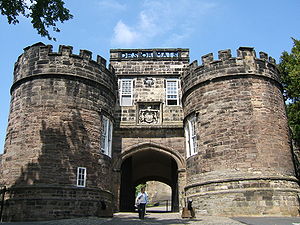Skipton Castle
| Skipton Castle | |
|---|---|
| Skipton, North Yorkshire, England | |
 Skipton Castle gatehouse | |
| Coordinates | 53°57′49″N 2°0′56″W / 53.96361°N 2.01556°W |
| Type | Castle |
| Site information | |
| Owner | The Fattorini family |
| Open to the public | Yes |
| Condition | Complete |
| Site history | |
| Built | c. 1090 |
| Built by | Robert de Romille |
| In use | Until December 1645 |
| Materials | Sandstone |
Skipton Castle is situated within the town of Skipton, North Yorkshire, England. The castle has been preserved for over 900 years, built in 1090 by Robert de Romille, a Norman baron.
History
The castle has stood for 900 years, first built as a Motte and Bailey castle in 1090 by Robert de Romille, a Norman baron. The castle was soon replaced with a stone keep as the old Motte and Bailey constructed was not enough to withstand the attacks from the Scots to the north.
In 1310, Edward II granted the property of the castle to Robert Clifford who was appointed Lord Clifford of Skipton and Guardian of Craven [1]. Robert Clifford ordered many improvements to the fortifications of the castle but died in the Battle of Bannockburn in 1314 when the improvements were barely complete.
During the English Civil War it was the only remaining Royalist stronghold in the north of England until December 1645. After a 3 year siege, a surrender was negotiated in 1645 between Oliver Cromwell and the Royalists. Oliver Cromwell ordered the removal of the castle roofs.
Skipton remained the Cliffords' principal seat until 1676. Lady Anne Clifford (1590-1676) was the last Clifford to own Skipton castle. After the 3 year siege, she ordered repairs and as a commemoration she planted a yew tree in the central courtyard to mark the Castle's repair from the English Civil War.
Today it stands as one of the most preserved medieval castles in England and is both a tourist attraction and a private residence.
Layout
The main castle consists of six drum towers, with a domestic range connecting the two towers on the northern side, protected by a precipice overlooking Eller Beck. The first floor comprises the original kitchen, great hall, withdrawing rooms and the lord's bedchamber. New kitchens, storage and work cellars make up the ground floor. The remaining towers are mainly military in nature and purpose. 16th and 17th century additions have created a new entrance staircase (replacing the original drawbridge), a further domestic wing, and new, larger windows in the original structure. In the centre is a courtyard, known as the Conduit Court, which contains a yew tree, reputedly planted by Lady Anne.

The outer curtain wall encloses the inner wards and various subsidiary buildings, including the ruins of a 12th century chapel. The wall is mainly extant, and is pierced by a twin-towered Norman gatehouse. The East tower of the gatehouse contains a 17th century shell grotto, one of only two remaining grottos from this period (the other is at Woburn Abbey).
See also
References
- Skipton Castle (guidebook), Jarrod Publishing, 1999

